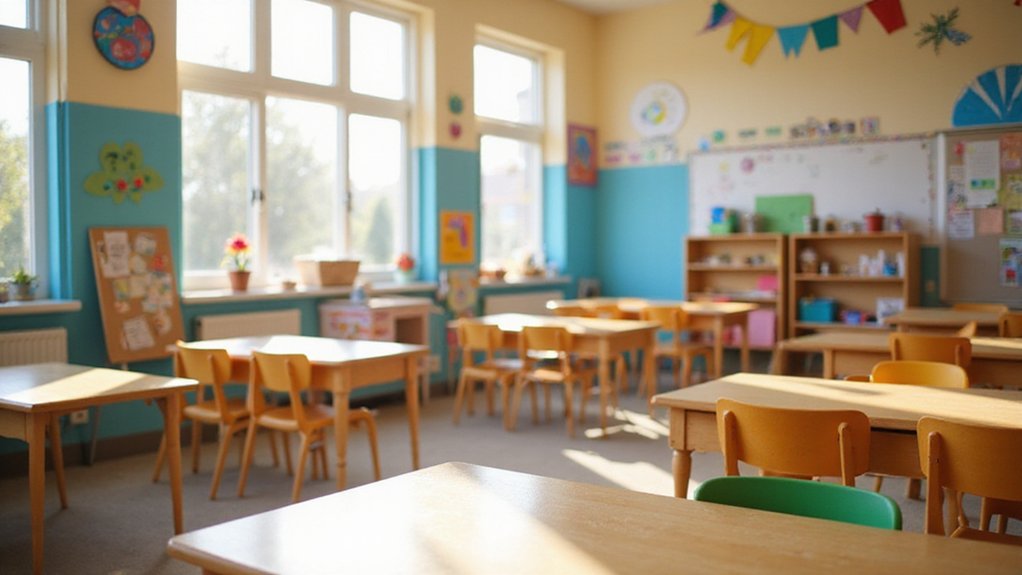When it comes to painting schools, you’re not just choosing a color scheme – you’re making a decision that impacts the health of students, teachers, and staff. Traditional paints can release hazardous chemicals into the air, putting everyone at risk. But what if you could create a lively learning environment without compromising indoor air quality? You’re about to uncover the benefits of VOC paints and how to make an informed decision that prioritizes both aesthetics and well-being.
Understanding Low-VOC Paints
When selecting paints for schools and daycares, you should prioritize products that minimize indoor air pollution, and that’s where low-VOC paints come in. Low-VOC (Volatile Organic Compound) paints have a lower concentration of solvents that evaporate quickly, reducing paint emissions and indoor air pollution.
You’ll find that low-VOC paints have a different paint composition compared to traditional paints. They contain fewer hazardous chemicals, making them a safer choice for learning environments. As you investigate low-VOC options, look for products that meet standards set by organizations like Greenguard Gold or California Air Resources Board (CARB). These certifications confirm the paints meet rigorous requirements for chemical emissions, making them suitable for schools and daycares. Additionally, opting for non-toxic, eco-friendly paints ensures a healthier space for children and staff while maintaining high-quality results.
Health Risks Associated With Traditional Paints
Because you’re considering paints for schools and daycares, you need to understand the health risks linked to traditional options. Traditional paints contain volatile organic compounds (VOCs) that evaporate quickly, releasing harmful chemicals into the air. This chemical exposure can lead to:
- Respiratory problems, such as asthma and bronchitis
- Eye, nose, and throat irritation
- Dizziness, headaches, and nausea
Prolonged exposure to these chemicals can have long-term effects, including cancer and neurological disorders. It’s imperative to prioritize the health and well-being of students, teachers, and staff by choosing safer painting options. Additionally, using quality paints can provide protection from elements and help maintain a safe environment for children and staff.
Eco-Friendly Painting Options for Schools
You can opt for eco-friendly painting options that prioritize the health and well-being of students, teachers, and staff. By choosing sustainable paint application methods can reduce the impact on the environment.
Consider using eco-conscious paint maintenance practices to minimize waste and emissions. This not only benefits the environment but also contributes to a healthier learning environment.
As a responsible educator, you want to guarantee that your school or daycare is a safe haven for children to grow and thrive. By adopting eco-friendly painting options, you’re taking a significant step towards creating a healthier and more sustainable learning environment.
What to Look for in Low-VOC Paints
Selecting low-VOC paints is imperative in minimizing indoor air pollution. When choosing a low-VOC paint, you want to verify it meets certain standards.
Here are key factors to consider:
- Ingredient quality: Look for paints that disclose their ingredients and avoid harmful chemicals. A high-quality paint will have a safer composition, reducing the risk of indoor air pollution.
- VOC levels: Compare different paints’ VOC levels, and opt for those with the lowest levels. This will help minimize the amount of pollutants released into the air.
- Third-party certifications: Check for certifications from organizations like Greenguard Gold or California Air Resources Board (CARB). These certifications confirm the paint meets rigorous standards for indoor air quality.
Best Practices for Painting in Schools
When preparing to paint, it’s essential that you take necessary precautions to minimize interruptions and guarantee a safe, healthy environment for students and staff. This includes scheduling the project during breaks or summer vacations when possible.
If painting must occur during school hours, identify areas that can be partitioned off to reduce student exposure.
In terms of paint application techniques, consider using rollers with extension poles to diminish ladder use and minimize the risk of accidents. Ensure that all surfaces are properly prepared, and apply paint in thin, even coats to prevent drips and unevenness. Effective space planning is also indispensable, as it helps you allocate resources efficiently and complete the project quickly, lessening disruptions to the learning environment.
Non-Toxic Color Schemes for Learning Environments
As educational environments increasingly focus on providing a thorough learning experience, the importance of incorporating non-toxic color schemes into school design can’t be overstated. You want to create a space that promotes learning and well-being.
To do this, consider the following elements:
- Calming color palettes such as light blue, yellow, and green, which have been shown to reduce stress and anxiety in students.
- Engaging texture choices like smooth walls, rough rugs, and tactile fabrics that stimulate students’ senses and create a sense of exploration and curiosity.
- Incorporating natural elements like plants, wood accents that bring the outdoors in and create a sense of calm, reducing feelings of overwhelm and discomfort.
These non-toxic color schemes and design elements come together to form a learning environment that’s both visually appealing and supportive of students’ overall well-being.
Long-Term Benefits of Low-VOC Paints
You’ve likely considered the immediate impact of a well-designed learning environment on students’ well-being.
But have you thought about the long-term benefits of low-VOC paints?
Frequently Asked Questions
Can I Use Low-Voc Paint on Previously Painted Walls?
When repainting, you’ll need to assess the wall’s condition before applying low-VOC paint. Proper painting preparation techniques guarantee durability over time; clean the surface, fix cracks, and sand rough spots to affirm a smooth, long-lasting finish.
Do Low-Voc Paints Have a Stronger Odor Than Traditional Paints?
You’ll find that low-VOC paints typically have a reduced chemical smell, offering lower toxic exposure compared to traditional paints, making them a better choice for your space.
Can Low-Voc Paints Be Mixed With Traditional Paints?
When you combine low-VOC paints with traditional paints, you’ll face paint mixing compatibility issues, potentially affecting paint color matching. It’s best to stick with one type to guarantee a uniform finish and avoid unwanted color variations.
Are Low-Voc Paints More Expensive Than Traditional Paints?
You’ll find that low-VOC paints often come at a slightly higher price point, but their reduced environmental impact makes them a precious investment for your projects, aligning with your values and priorities.
Can Low-Voc Paints Be Used on Wood Furniture and Toys?
When refinishing wood furniture or toys, you’ll want to guarantee the paint adheres well and doesn’t jeopardize furniture durability or toy safety considerations; low-VOC paints can be a great option, but make certain to select a product specifically designed for your project’s unique needs.

